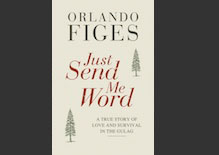|
INTERVIEWER: Fifteen years have past since the publication of A People's Tragedy. The book has been translated into many languages, won numerous prizes, and sold a quarter of million copies round the world. Are you surprised by its success?
ORLANDO FIGES: Yes, I think I am, it's a big book, almost a thousand pages, and I would expect that to put people off. But, you know, many of my readers are students, they use the book in UK schools, and I get a great response from them in emails, or when I go to talk at schools. So that is really uplifting, if a bit surprising, that teenagers can get so much from a big and complex book.
INTERVIEWER: You were a relatively young man when you wrote the book. Wasn't it a bit ambitious to set out to write a book like that?
ORLANDO FIGES: I was 36 when the book came out, 30 when I started work on it. Looking back, of course I'd have to say it was a bit ambitious to embark on a book like that. To some extent I was inspired by Simon Schama's Citizens and thought I could do for the Russian Revolution what he had done for the French. But by 1990 I had worked already for six years in the Soviet archives. I had seen them open up, had been among the first Western scholars to work with archival documents from the Revolution of 1917 and the Civil War, and I had a good sense of what it would be possible to do. I thought the time was right to do a general history of the whole revolutionary period free from the political categories of the Cold War. What the opening of the archives made possible was to work with documents that brought to life the individual human experience of the Revolution - diaries and letters written by people caught up in the events - whereas previous histories had concentrated on political parties, ideologies and classes.
INTERVIEWER: Your first book was on the peasantry. How much did that influence your conception of A People's Tragedy?
ORLANDO FIGES: Very much. Russia was a peasant society and all the major shifts in Russian history have rested on that social base. I don't think you can write anything sensible about Russian history unless you have studied the peasantry in depth. My first book was a detailed study of the peasantry of the Volga region in the Revolution and the Civil War. I used the documents of village committees and soviets in the Moscow and provincial archives to explore the ways in which the victory of the Bolsheviks was made possible by social and generational divisions within the countryside. But for A People's Tragedy I also looked at what you might call the political culture of the peasantry, highlighting the concepts of social justice in customary law and the ways in which power relationships were mediated by coercion, violence. Until 1904, Peasants could be flogged by gentry magistrates for minor misdemeanours - a fact I always flag to students as essential for an understanding of the peasant violence in 1905 and 1917. There was an element of retribution and revenge in the revolutionary violence and I made a point of this because it seems to me it was the key to Lenin's calls for Civil War. He called it 'looting the looters'.
INTERVIEWER: Why did you start in 1891 and why end in 1924?
ORLANDO FIGES: I thought it was important to view the Revolution in the longue durée. I chose 1891 because there was a famine in that year and it politicized society in a way that propelled Russia towards Revolution in 1905. The Revolution started from the friction between the political demands of the educated classes - outraged by the suffering of the people - and the reactionary impulses of the Tsarist government. As for 1924, that's obvious enough, the death of Lenin, by which time, I believe, the revolution had turned a full circle and the basic institutions, if not all the practises of the Stalinist regime were in place. The Revolution was not over - in a way it did not end until 1991 - but this seemed a good place to end the book.
INTERVIEWER: How did you select the characters that run through the narrative?
ORLANDO FIGES: By a process of elimination. The opening of the archives allowed me to work through a much larger number of personal collections (diaries, letters and so on) than would have been possible before. That is what I decided to focus on in my work in the archives. I think I worked through about a hundred personal archives to find the six I chose for A People's Tragedy. The writer Maxim Gorky chose himself - because he was such an obvious example of a writer torn between his commitment to the Revolution and his horror at its violence. General Brusilov and Prince Lvov were also emblematic of broader tragedies involving concepts of patriotic service and liberty. Other figures were relatively unknown - the peasant reformer Sergei Semenov
and the soldier-commissar Dmitry Oskin - but also representative of collective destinies. My aim was to present the Revolution not as a march of abstract social forces and ideologies but as a human event of complicated individual tragedies. All these figures entered into the public events of the Revolution with high ideals to achieve one thing, only to find out that the outcome was quite different. That is why I called the book A People's Tragedy. It is not just about the tragic turning-point in the history of a people, but about the ways in which the tragedy of the Revolution engulfed the destinies of those who lived through it.
INTERVIEWER: How does this approach to the individual element relate to your conception of writing history?
ORLANDO FIGES: I think it has evolved, starting from A People's Tragedy but also in my later books. The point, I think, is to communicate historical meaning not as an abstraction delivered from on high by the Historian, but by getting the reader to understand events, with all their complications, from inside, and from different perspectives, and - this is the most important part - to feel that meaning in human and emotional terms. What I like about meeting readers of A People's Tragedy is that they have so many different responses to the book. I don't want my readers to take away one meaning or interpretation from my work. I want them to engage with what I write with their own emotions and experience.
INTERVIEWER: People say your history reads like a novel. Is that what you want?
ORLANDO FIGES: I certainly want it to be readable and to count as literature. And the point of writing history well, of emplotting history as a narrative, is to make the reader feel, engage imagination, empathize and understand. There are problems with emplotting history - you can level criticisms at A People's Tragedy for giving to the events of the Revolution a dramatic shape. But history is not science - there is no objective way of telling it. History is literature. It tells stories which it claims are true.
INTERVIEWER: Is there anything in the book that you would change with hindsight after fifteen years?
ORLANDO FIGES: That's an interesting question which I've thought about a lot. The main thing I would reconsider is perhaps the role of Stolypin. I think he was a braver and more visionary leader than perhaps I gave him credit for. Maybe too I would write a little more about the international aspects of the Revolution after 1917. But that is something I will return to in my next book, A Concise History of the Revolution.
INTERVIEWER: How will that book differ from A People's Tragedy?
ORLANDO FIGES: Well, it will be a lot shorter - a hundred years of the Revolution (from 1891 to 1991) in under 200 pages - so easier for schools to use. Otherwise, I am afraid, you will have to wait and see.
|






